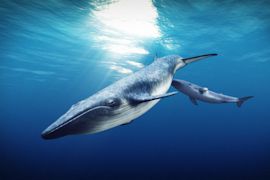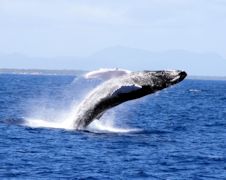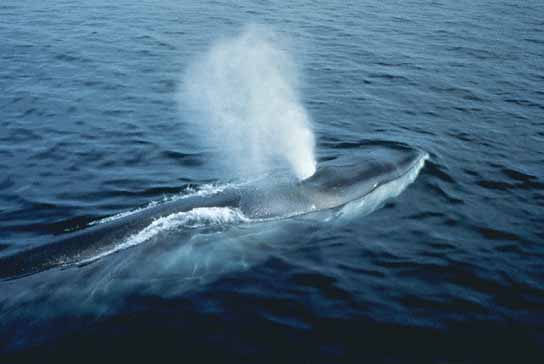Marine Mammals
Description
To 79' (24.1 m). Fusiform, tapering posteriorly; blue-black above, undersides white. Grayish-white chevron behind head, apex on dorsal midline, arms extending backward. Right lower lip, including mouth cavity, yellowish white, right upper lip occasionally also white, left lips dark. Right front baleen plates white, remainder striped with alternate yellowish-white. Snout V-shaped with single median dorsal ridge; top of head flat, with paired blowholes. Dorsal fin steeply angled, placed far back. Back distinctly ridged posterior to dorsal fin. Ventral grooves extend at least to navel.
Range
In Atlantic from Arctic Circle to Greater Antilles, including Gulf of Mexico. In Pacific from Bering Sea to Cabo San Lucas, Baja California.
Discussion
The Fin Whale is also known as the Finback Whale, Finner Whale, and Common Rorqual. In addition, it is called the Razorback Whale because of the ridges between the dorsal fin and the tail. The falcate dorsal fin, an obvious characteristic, is easily seen at sea. The Fin Whale feeds on small fishes, pelagic crustaceans, and squids. It sometimes leaps clear of the surface, yet is also a deeper diver than some of the other baleen whales.
Dating Whales
The age of a tree can be determined by studying its trunk. Likewise, the age
of certain whales can be determined by examining their ears.
The ear wax of Fin Whales and some other species of baleen whales is different
from the kind that clogs our own ears. The whale variety forms a hard plug that
seems to improve hearing rather than impair it. Also, the ear wax of these
whales thickens in distinct layers each year -- two layers annually for the
Fin Whale, while the Humpback Whale appears to add four layers of ear wax per year.
Once a person knows the appropriate rate of wax buildup for a given species, it's
relatively easy to calculate the whale's age. Unfortunately, the whale must be dead
in order for its ear plug to be extracted and studied. The surest method for
determining the age of a living whale is to check its ID.






